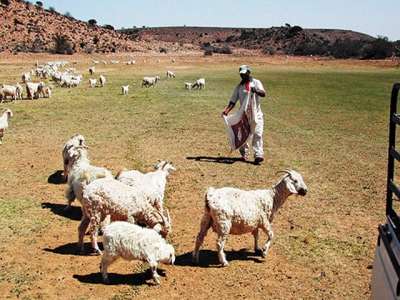Efficient feeding during drought

Precision feeding can take the sting out of a drought, according to Dr Chris Landman, a feed specialist and consultant. Roelof Bezuidenhout reports.
Taking a scientific approach to drought feeding could pay dividends. Photo: Roelof Bezuidenhout
Drought feeding is a fairly complicated procedure that takes into account the interaction between minerals in the grazed plants and animals under various veld conditions. The interactions vary from area to area, making technical knowledge essential if a farmer wants to feed more efficiently and cheaply.
The complexity of this is well illustrated by copper. Excess copper causes molybdenum deficiency and can deplete zinc in the animal’s liver. Furthermore, iron utilisation depends on copper concentration in the diet. Too much copper can increase blood iron concentration, reducing selenium levels.
Rain vs drought
Straight after rain, ephemerals (opportunistic plants or opslag) high in salt and minerals appear almost overnight. These are followed by fast-growing plants rich in energy and vitamins, which, as they reach maturity, undergo an increase in protein, fibre and dry-matter content.
The opposite happens during a drought. Plants turn from green to brown and later to black. When the opslag disappears, it becomes necessary to add energy, fat and especially fat-soluble vitamins (Vitamin A) to the diet.
In an advanced stage of drought, plants are critically short in protein, dry matter and fibre. The calcium concentration increases, as it does in winter. Usually, a high calcium and/or iron concentration in plants is the main reason for the poor absorption of energy, minerals and vitamins from the digestive track to the blood and liver.
This occurs due to a more alkaline digestive tract and an insoluble compound of calcium, phosphorus and magnesium, which leads to a deficiency of phosphate and magnesium, as these minerals are excreted in manure and urine.
If you get ‘good’ results with mineral injections, this could be a sign that something is wrong with the flock’s or herd’s absorption of minerals through the alimentary canal wall. Where necessary, you can save money on phosphate, manganese, zinc, iodine, cobalt, copper and especially selenium by using a lick low in calcium and iron due to improved absorption of minerals and trace elements.
Supplementary feed and licks
In overgrazed veld where fodder is scarce, lucerne and drought pellets will be the best supplementary feed. But in veld in reasonable condition, a tailor-made lick could be better.
Drought pellets are high in fibre, calcium and perhaps iron, but the overall nutritive value is lower than needed for maintenance.
Lucerne supplies protein, but contains too much roughage and calcium, while energy is too low for production. Feeding lucerne only is thus not the best option.
Much of the fibre available in the vegetation is wasted because of injudicious supplementary feeding. This is a great problem throughout South Africa. While adult ruminants need 20% fibre, and growing ruminants require 15% in their diet, the veld provides more than 30%. This can increase even further during a drought.
This means that, under normal conditions, each adult ruminant will use the fibre of 1,5 animals, while each growing ruminant (lamb or calf) will excrete that of two animals. With a lick tailor-made for your farm and animals, fibre use will be more effective and will be available for longer in any specific grazing camp during drought.
Rumen microbes can, of course, produce protein from non-protein nitrogen (NPN), as well as vitamins, enzymes and other vital compounds, via essential amino acids and fatty acids. The problem is that these nutrients are not enough for production or to maintain fertility.
Improving feed conversion
Another problem is that too much nitrogen in the form of NPN will cause the animal to use unnecessary energy and water (both scarce during drought) to excrete it through the urine. A balanced diet will thus save energy and water.
Providing a concentrated salt lick (10g/day to 20g/ day intake) with the necessary nutritional elements to ensure fertility is more profitable than feeding tons of less valuable constituents.
Enzymes consumed at the correct concentration can improve the grazing capacity of a farm by more than 20% through improved feed conversion. This is because enzymes help rumen microbes to harvest more protein and energy from the cellulose in the forage as well as carry nutrients through the alimentary canal wall into the bloodstream.
Therefore, it is best to start drought feeding by giving the animals what they need and adding what the veld lacks. Put another way – you could be wasting veld by not providing the right lick.
Related news
Tools

Phối trộn thức ăn chăn nuôi

Pha dung dịch thủy canh

Định mức cho tôm ăn

Phối trộn phân bón NPK

Xác định tỷ lệ tôm sống

Chuyển đổi đơn vị phân bón

Xác định công suất sục khí

Chuyển đổi đơn vị tôm

Tính diện tích nhà kính

Tính thể tích ao



 Fruit by-products provide a cheaper fiber alternative for…
Fruit by-products provide a cheaper fiber alternative for…  US: Low-quality forage prompts concerns about cattle, ruminant…
US: Low-quality forage prompts concerns about cattle, ruminant…